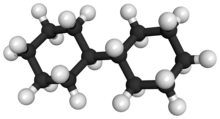Bicyclohexyl
Bicyclohexyl, also known as dicyclohexyl or bicyclohexane, is an organic chemical with the formula C12H22 and a molecular mass of 166.303 g mol−1. It is a nonvolatile liquid at room temperature, with a boiling point of 227 °C (441 °F). Its structure consists of two cyclohexane rings joined by a single carbon-carbon bond.
 | |
 | |
| Names | |
|---|---|
Other names
| |
| Identifiers | |
3D model (JSmol) |
|
| ChEMBL | |
| ChemSpider | |
| ECHA InfoCard | 100.001.966 |
| EC Number |
|
PubChem CID |
|
| UNII | |
CompTox Dashboard (EPA) |
|
| |
| |
| Properties | |
| C12H22 | |
| Molar mass | 166.308 g·mol−1 |
| Appearance | Colorless liquid |
| Density | 0.88273 g/cm3 |
| Melting point | 4 °C (39 °F; 277 K) |
| Insoluble | |
| Solubility in other solvents | Miscible with organic solvents |
Refractive index (nD) |
1.4796[1] |
| Hazards | |
| GHS pictograms |   |
| GHS Signal word | Warning |
GHS hazard statements |
H315, H319, H400, H410 |
| P264, P273, P280, P302+352, P305+351+338, P321, P332+313, P337+313, P362, P391, P501 | |
| Flash point | 92 °C (198 °F; 365 K) |
| 245 °C (473 °F; 518 K) | |
Except where otherwise noted, data are given for materials in their standard state (at 25 °C [77 °F], 100 kPa). | |
| Infobox references | |
Production
Carbazole can be denitrogenated by hydrogen to yield bicyclohexyl as the main product.[2]
When cyclohexane is exposed to radiation, bicyclohexyl is produced among other hydrocarbons.[3]
Properties
The molecule is not completely flat, and the two rings are twisted compared to each other. Liquid bicyclohexyl contains a mixture of molecules with C2 and C2h symmetry termed ee anti, and ee gauche. The carbon-carbon bond (pivot) between the rings is 1.55 Å, and the carbon-carbon length in the rings is 1.535 Å and carbon-hydrogen bond length is 1.102 Å. The torsion angle between the rings is 74.9°. The C-C-C bond angle ∠ is about 111° and C-C-H angle is 109°.[4]
The speed of sound in bicyclohexyl is 1441.51 m/s, higher than many other hydrocarbons. The density is 882.73 kgm−1. The isothermal compressibility is 674 TPa−1 and isobaric expansivity is 819 K−1.[5]
When bicyclohexyl is heated to around 427 °C (801 °F) it slowly decomposes to cyclohexane and cyclohexene, as the pivot bond joining the two rings is the longest and weakest one.[6]
Heat of combustion is 1814.8 kcal/mol.[7]
Use
Bicyclohexyl has uses in organic synthesis as a building block and structural motif, in studying the chemistry of liquid interfaces,[8] and in surface modification of metal oxides as a solvent.[9]
See also
References
- Ferris, S. W. (2013). Handbook of Hydrocarbons. Elsevier. p. 214. ISBN 9781483272856.
- Occelli, Mario L. (1996). Hydrotreating Technology for Pollution Control: Catalysts, Catalysis, and Processes. CRC Press. pp. 263–265. ISBN 9780824797560.
- Nixon, A. C.; Thorpe, R. E. (May 1958). "Radiation Chemistry of Cyclohexane". The Journal of Chemical Physics. 28 (5): 1004–1005. doi:10.1063/1.1744261.
- Dorofeeva, O.V.; Mastryukov, V.S.; Almenningen, A.; Horn, A.; Klaeboe, P.; Yang, L.; Allinger, N.L. (December 1991). "Molecular structure and conformations of bicyclohexyl, (C6H11)2, as studied by electron diffraction, vibrational spectroscopy and molecular mechanics". Journal of Molecular Structure. 263: 281–297. doi:10.1016/0022-2860(91)80071-B.
- Tardajos, G.; Diaz Pena, M.; Lainez, A.; Aicart, E. (October 1986). "Speed of sound in and isothermal compressibility and isobaric expansivity of pure liquids at 298.15 K". Journal of Chemical & Engineering Data. 31 (4): 492–493. doi:10.1021/je00046a031.
- Yue, Lei; Qin, Xiaomei; Wu, Xi; Guo, Yongsheng; Xu, Li; Xie, Hujun; Fang, Wenjun (2 July 2014). "Thermal Decomposition Kinetics and Mechanism of 1,1′-Bicyclohexyl". Energy & Fuels. 28 (7): 4523–4531. doi:10.1021/ef501077n.
- Good, W.D.; Lee, S.H. (July 1976). "The enthalpies of formation of selected naphthalenes, diphenylmethanes, and bicyclic hydrocarbons". The Journal of Chemical Thermodynamics. 8 (7): 643–650. doi:10.1016/0021-9614(76)90015-X.
- Thoma, M; Schwendler, M; Baltes, H; Helm, C. A; Pfohl, T; Riegler, H; Möhwald, H (1996). "Ellipsometry and X-ray Reflectivity Studies on Monolayers of Phosphatidylethanolamine and Phosphatidylcholine in Contact withn-Dodecane,n-Hexadecane, and Bicyclohexyl". Langmuir. 12 (7): 1722. doi:10.1021/la9508194.
- Pujari, Sidharam P; Scheres, Luc; Marcelis, Antonius T. M; Zuilhof, Han (2014). "Covalent Surface Modification of Oxide Surfaces". Angewandte Chemie International Edition. 53 (25): 6322. doi:10.1002/anie.201306709. PMID 24849332.